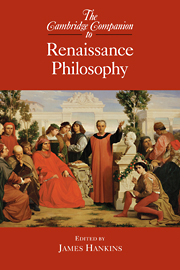Book contents
- Frontmatter
- 1 Introduction
- Part I Continuity and Revival
- 2 The philosopher and Renaissance culture
- 3 Humanism, scholasticism, and Renaissance philosophy
- 4 Continuity and change in the Aristotelian tradition
- 5 The revival of Platonic philosophy
- 6 The revival of Hellenistic philosophies
- 7 Arabic philosophy and Averroism
- 8 How to do magic, and why philosophical prescriptions
- Part II Toward Modern Philosophy
- Appendix: Brief biographies of Renaissance philosophers
- Bibliography
- Index
6 - The revival of Hellenistic philosophies
from Part I - Continuity and Revival
Published online by Cambridge University Press: 28 November 2007
- Frontmatter
- 1 Introduction
- Part I Continuity and Revival
- 2 The philosopher and Renaissance culture
- 3 Humanism, scholasticism, and Renaissance philosophy
- 4 Continuity and change in the Aristotelian tradition
- 5 The revival of Platonic philosophy
- 6 The revival of Hellenistic philosophies
- 7 Arabic philosophy and Averroism
- 8 How to do magic, and why philosophical prescriptions
- Part II Toward Modern Philosophy
- Appendix: Brief biographies of Renaissance philosophers
- Bibliography
- Index
Summary
In the Renaissance the Hellenistic period was not recognized as a distinctive phase in the development of ancient philosophy. Only in the nineteenth century was the term “Hellenistic” adopted to describe the three centuries between the dissolution of Alexander the Great’s empire, following his death in 323 bc, and the beginning of the Roman Empire in 31 bc, in the aftermath of the Battle of Actium. The three main philosophies nowadays classified as Hellenistic - Stoicism, Epicureanismand skepticism (in both its Academic and Pyrrhonist forms) - fall broadly within that timeframe, though the chronological boundaries are sufficiently elastic to include the Stoics Seneca, Epictetus and Marcus Aurelius, who lived in the first and second centuries ad. For all three Hellenistic schools, the aim of studying philosophy was to attain a state of calmness and peace of mind in our daily lives. Each school, however, set out a different path to that goal: for the Stoics, it lay in rooting out pathological emotions; for the Epicureans, in eliminating irrational fears of the afterlife and unnatural desires in the present life; and for the skeptics, in removing the anxiety produced by the futile search for certain knowledge. Renaissance interest in the Hellenistic schools centered on these competing claims.
Lacking any collective identity as Hellenistic philosophies, Stoicism, Epicureanism and skepticism each underwent its own revival over the course of the fifteenth and sixteenth centuries, as part of the ongoing recovery of ancient literature and thought. Although these sects became much better known than they had been in the Middle Ages, they nevertheless remained on the margins of Renaissance philosophical culture, which continued to be dominated, particularly in the universities, by Aristotelianism. Many of those who engaged with the Hellenistic sects were not philosophers but humanists, vernacular authors, and religious thinkers. And approval or disapproval of these sects usually turned on theological rather than philosophical considerations.
- Type
- Chapter
- Information
- The Cambridge Companion to Renaissance Philosophy , pp. 97 - 112Publisher: Cambridge University PressPrint publication year: 2007
- 15
- Cited by

